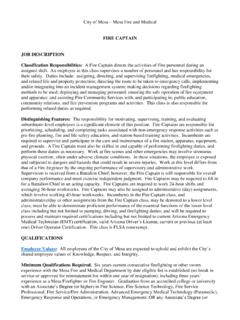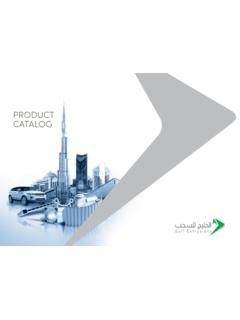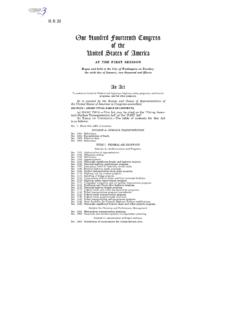Transcription of Vapor Recovery Tower/ VRU Configuration - US EPA
1 Vapor Recovery Tower/ VRU. Configuration Lessons Learned from natural Gas STAR. Occidental Petroleum Corporation and California Independent Petroleum Association Producers Technology Transfer Workshop Long Beach, California August 21, 2007. Vapor Recovery : Agenda Methane Losses Methane Savings Is Recovery Profitable? Industry Experience Lessons Learned Discussion 1. Methane Losses from Storage Tanks Storage tanks are responsible for 4% of methane emissions in natural gas and oil production sector 96% of tank losses occur from tanks without Vapor Recovery Storage Tank Other Venting Sources Pneumatic Meters and 6 Bcf 12 Bcf Devices Pipeline Leaks 57 Bcf 9 Bcf Well Venting and Flaring 9 Bcf Gas Engine Exhaust Inventory of 12 Bcf Greenhouse Gas Emissions Dehydrators Offshore and Sinks 1990 - 2005. and Pumps Operations 17 Bcf Bcf = billion cubic feet 34 Bcf 2. Sources of Methane Losses A storage tank battery can vent 4,900 to 96,000 thousand cubic feet (Mcf) of natural gas and light hydrocarbon vapors to the atmosphere each year Vapor losses are primarily a function of oil throughput, gravity, and gas-oil separator pressure Flash losses Occur when crude is transferred from a gas-oil separator at higher pressure to a storage tank at atmospheric pressure Working losses Occur when crude levels change and when crude in tank is agitated Standing losses Occur with daily and seasonal temperature and barometric pressure changes 3.
2 Methane Savings: Vapor Recovery Vapor Recovery can capture up to 95% of hydrocarbon vapors from tanks Recovered vapors have higher heat content than pipeline quality natural gas Recovered vapors are more valuable than natural gas and have multiple uses Re-inject into sales pipeline Use as on-site fuel Send to processing plants for recovering valuable natural gas liquids 4. Types of Vapor Recovery Units Conventional Vapor Recovery units (VRUs). Use rotary or vane compressor to suck vapors out of atmospheric pressure storage tanks Scroll compressors are new to this market Require electrical power or engine driver Venturi ejector Vapor Recovery units (EVRUTM) or Vapor Jet Use Venturi jet ejectors in place of rotary compressors Contain no moving parts EVRUTM requires a source of high pressure motive gas and intermediate pressure discharge system Vapor Jet requires a high pressure water motive 5. Conventional Vapor Recovery Unit Vent Line Back Pressure Valve Control Source: Evans & Nelson (1968).
3 Pilot Suction Line Electric Control Panel Crude Oil Bypass Stock Valve Suction Tank(s). Scrubber Gas Gas Sales Meter Run Check Valve Condensate Liquid Electric Driven Sales Transfer Pump Rotary Compressor Return 6. Vapor Recovery Installations 7. Venturi Jet Ejector*. Pressure Indicator Temperature Indicator PI TI PI TI. High-Pressure Discharge Gas Motive Gas (~40 psia). (~850 psig). TI. Flow Safety Valve PI Suction Pressure ( to 0 psig). Low-Pressure Vent Gas from Tanks ( to psig). *EVRUTM Patented by COMM Engineering Adapted from SRI/USEPA-GHG-VR-19. psig = pound per square inch, gauge psia = pounds per square inch, absolute 8. Vapor Recovery with Ejector Compressor Gas to Sales 6,200 Mcf/day @ 1000 psig 281 Mcf/day Gas Net Recovery (19 Mcf/day incremental 5,000 Mcf/day Gas 5,000 barrels/day Oil fuel) 900 Mcf/day Ejector 40 psig LP. Separator Ratio Motive / Vent = 3. = 900/300. 300 Mcf/day Gas Mcf = Thousand cubic feet Oil & Gas Oil Well Crude Oil Stock Tank Oil to Sales 9. Vapor Jet System*.
4 *Patented by Hy-Bon Engineering 10. Vapor Jet System*. Utilizes produced water in closed loop system to effect gas gathering from tanks Small centrifugal pump forces water into Venturi jet, creating vacuum effect Limited to gas volumes of 77 Mcf/day and discharge pressure of 40 psig *Patented by Hy-Bon Engineering 11. Criteria for Vapor Recovery Unit Locations Steady source and sufficient quantity of losses Crude oil stock tank Flash tank, heater/treater, water skimmer vents Gas pneumatic controllers and pumps Outlet for recovered gas Access to low pressure gas pipeline, compressor suction, or on-site fuel system Tank batteries not subject to air regulations 12. Quantify Volume of Losses Estimate losses from chart based on oil characteristics, pressure, and temperature at each location ( 50%). Estimate emissions using the E&P Tank Model ( 20%). Engineering Equations Vasquez Beggs ( 20%). Measure losses using recording manometer and well tester or ultrasonic meter over several cycles ( 5%).
5 This is the best approach for facility design 13. Estimated Volume of Tank Vapors 110. 100. Vapor Vented from Tanks, 90. API Gravities cubic foot / barrel 80 r O ve Gas/Oil Ratio d 70 an API. PI. 60 40 A. to 39 . 50 API. 30 . 40. r 30 API. 30 Unde 20. 10. 10. 20 30 40 50 60 70 80. Pressure of Vessel Dumping to Tank (Psig). o API = API gravity 14. Final Stage of Separation Atmospheric tanks may emit large amounts of tank vapors at relatively low separator pressure Vasquez-Beggs Equation Example for Huntington Beach Crude Goil API. Gflash gas Tsep 100 F. Psep 3 psig GOR = scf/bbl psig pounds per square inch, gauge scf standard cubic feet bbl barrels 15. What is the Recovered Gas Worth? Value depends on heat content of gas Value depends on how gas is used On-site fuel Valued in terms of fuel that is replaced natural gas pipeline Measured by the higher price for rich (higher heat content) gas Gas processing plant Measured by value of natural gas liquids and methane, which can be separated 16.
6 Value of Recovered Gas Gross revenue per year = (Q x P x 365) + NGL. Q = Rate of Vapor Recovery (Mcf per day). P = Price of natural gas NGL = Value of natural gas liquids 17. Value of natural Gas Liquids 1 2 3 4. Btu/gallon MMBtu/ $/gallon $/MMBtu1,2,3. gallon (=3/2). Methane 59,755 Ethane 74,010 Propane 91,740 n Butane 103,787 iso Butane 100,176 Pentanes+ 105,000 5 6 7 8 9 10 11. Btu/cf MMBtu/Mcf $/Mcf $/MMBtu Vapor Mixture Value (=4*6) Composition (MMBtu/Mcf) ($/Mcf). (=8*10). Methane 1,012 $ 82% $ Ethane 1,773 $ 8% $ Propane 2,524 $ 4% $ n Butane 3,271 $ 3% $ iso Butane 3,261 $ 1% $ Pentanes+ 4,380 $ 2% $ Total $ 1 natural Gas Price assumed at $ as on Mar 16, 2006 at Henry Hub 2 Prices of Individual NGL components are from Platts Oilgram for Mont Belvieu, TX January 11, 2006. 3 Other natural gas liquids information obtained from Oil and Gas Journal, Refining Report, March 19, 2001, p. 83. Btu = British Thermal Units, MMBtu = Million British Thermal Units, Mcf = Thousand Cubic Feet 18.
7 Cost of a Conventional VRU. Vapor Recovery Unit Sizes and Costs Capacity Compressor Capital Costs Installation Costs O&M Costs (Mcf/day) Horsepower ($) ($) ($/year). 25 5 to 10 20,421 10,207 to 20,421 7,367. 50 10 to 15 26,327 13,164 to 26,327 8,419. 100 15 to 25 31,728 15,864 to 31,728 10,103. 200 30 to 50 42,529 21,264 to 42,529 11,787. 500 60 to 80 59,405 29,703 to 59,405 16,839. Cost information provided by United States natural Gas STAR companies and VRU manufacturers, 2006 basis. 19. Is Recovery Profitable? Financial Analysis for a Conventional VRU Project Installation Annual Peak O&M Value of Simple Internal & Capital Savings Capacity Costs Gas2 Payback Rate of Costs1. (Mcf/day) ($/year) ($/year) ($) (months) Return ($). 25 $35,738 $7,367 $51,465 $44,098 10 121%. 50 $46,073 $8,419 $102,930 $94,511 6 204%. 100 $55,524 $10,103 $205,860 $195,757 4 352%. 200 $74,425 $11,787 $411,720 $399,933 3 537%. 500 $103,969 $16,839 $1,029,300 $1,012,461 2 974%. 1 Unit cost plus estimated installation of 75% of unit cost 2 $ x peak capacity x 365, Assumed price includes Btu enriched gas ( MMBtu/Mcf).
8 20. Industry Experience Top five United States companies for emissions reductions using VRUs in 2005. 2005 Annual Reductions Company (Mcf). Company 1 1,346,208. Company 2 313,753. Company 3 160,650. Company 4 54,597. Company 5 31,239. 21. Industry Experience: Anadarko Vapor Recover Tower (VRT). Add separation vessel between heater treater or low pressure separator and storage tanks that operates at or near atmospheric pressure Operating pressure range: 1 psi to 5 psi Compressor (VRU) is used to capture gas from VRT. Oil/Condensate gravity flows from VRT to storage tanks VRT insulates the VRU from gas surges with stock tank level changes VRT more tolerant to higher and lower pressures Stable pressure allows better operating factor for VRU. 22. Industry Experience: Anadarko VRT reduces pressure drop from approximately 50. psig to 1-5 psig Reduces flashing losses Captures more product for sales Anadarko netted between $7 to $8 million from 1993 to 1999 by utilizing VRT/VRU Configuration Equipment Capital Cost: $11,000.
9 Standard size VRTs available based on oil production rate 20 x 35'. 48 x 35'. Anadarko has installed over 300 VRT/VRUs since 1993 and continues on an as needed basis 23. VRT/VRU Photos Courtesy of Anadarko 24. VRT/VRU Photos Courtesy of Anadarko 25. Industry Experience: Oxy Oxy Case Study - Vapor Recovery Wasson Tank Battery (CDU 1 & 2). Denver City, Texas Installed in 2004. Oxy purchased two Vapor Recovery units in August 2004 for capturing vapors from two separate tank batteries at their Wasson facility Each battery produces approximately 450 Mcf/day of tank vapors, which Oxy needed to gather and compress into a 45 psig sales line Due to the low discharge pressure, Oxy selected rotary vane compressor packages capable of moving 500 Mcf/day In order to minimize maintenance, Oxy selected electric drive units 75 horsepower electric motors on each unit 26. Oxy Wasson Tank Battery 1 CDU 1. 27. Industry Experience: Oxy Cost per site Total Cost Capital Cost: $92,500 $185,000. Installation Cost: $9,500 $19,000.
10 Installed Cost: $102,000 $204,000. Gas Volume (Mcf/day): 450 900. Value at $7/Mcf: $3,150 $6,300. Annual Revenue: $1,149,750 $2,299,500. (with no BTU adjustment and no liquid sales). Monthly Incremental Revenue: $95,812 $191,625. Payback (in months): 28. Lessons Learned Vapor Recovery can yield generous returns when there are market outlets for recovered gas Recovered high heat content gas has extra value Vapor Recovery technology can be highly cost-effective in most general applications Venturi jet models work well in certain niche applications, with reduced operating and maintenance costs Potential for reduced compliance costs can be considered when evaluating economics of VRU, EVRUTM, or Vapor Jet 29. Lessons Learned (continued). VRU should be sized for maximum volume expected from storage tanks (rule-of-thumb is to double daily average volume). Rotary vane, screw or scroll type compressors recommended for VRUs where Venturi ejector jet designs are not applicable EVRUTM recommended where there is a high pressure gas compressor with excess capacity Vapor Jet recommended where there is produced water, less than 75 Mcf per day gas and discharge pressures below 40 psig 30.












